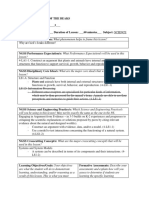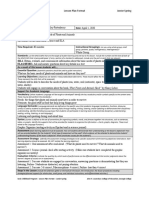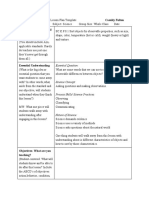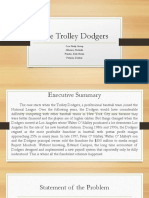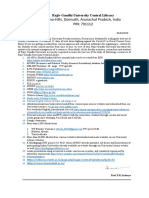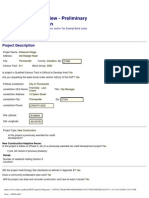Ede4942 Us2lessonplan
Ede4942 Us2lessonplan
Uploaded by
api-297176782Copyright:
Available Formats
Ede4942 Us2lessonplan
Ede4942 Us2lessonplan
Uploaded by
api-297176782Original Title
Copyright
Available Formats
Share this document
Did you find this document useful?
Is this content inappropriate?
Copyright:
Available Formats
Ede4942 Us2lessonplan
Ede4942 Us2lessonplan
Uploaded by
api-297176782Copyright:
Available Formats
USF Elementary Education Lesson Plan Template (S 2014)
What Standards (national
or state) relate to this
lesson?
(You should include ALL
applicable standards. Rarely
do teachers use just one:
theyd never get through
them all.)
Essential Understanding
(What is the big idea or
essential question that you
want students to come away
with? In other words, what,
aside from the standard and
our objective, will students
understand when they finish
this lesson?)
Objectives- What are you
teaching?
(Student-centered: What will
students know and be able to
do after this lesson? Include
the ABCDs of objectives:
action, behavior, condition,
and degree of mastery, i.e.,
"C: Given a sentence written
in the past or present tense,
A: the student B: will be able
to re-write the sentence in
future tense D: with no errors
in tense or tense contradiction
(i.e., I will see her
yesterday.)."
Note: Degree of mastery does
not need to be a percentage.)
Name: Amanda Silebi
Lesson Content
SC.3.L.15.1 Classify animals into major groups (mammals, birds, reptiles, amphibians,
fish, arthropods, vertebrates, and invertebrates, those having live births and those which
lay eggs) according to their physical characteristics and behaviors.
How can you classify animals based on their characteristics and behaviors? What are the
characteristics of an arthropod?
Students will be able to classify animals as arthropods according to their physical
characteristics and behaviors.
USF Elementary Education Lesson Plan Template (S 2014)
Name: Amanda Silebi
Rationale
Address the following
questions:
Why are you teaching this
objective?
Where does this lesson fit
within a larger plan?
Why are you teaching it
this way?
Why is it important for
students to learn this
concept?
I am teaching this objective so that the students are able to classify animals (specifically
arthropods) according to their characteristics. This lesson on arthropods fits into the
students ability to classify animals according to their characteristic.
Evaluation Plan- How will
you know students have
mastered your objectives?
Formative assessment: Students ability to complete the animal sort (magnet sort),
teacher made observations/notes during independent/buddy work, and the student
ability to answer questions throughout the lesson. Completion of the Arthropod portion
of the foldable.
Summative assessment: Students ability to answer the exit ticket question (what is an
arthropod/describe), and the students ability to complete the end of unit test (on
classifying animals according to their characteristic and behavior).
Address the following:
What formative evidence
will you use to document
student learning during
this lesson?
What summative evidence
will you collect, either
during this lesson or in
upcoming lessons?
What Content Knowledge
is necessary for a teacher
to teach this material?
What background
knowledge is necessary for
The teacher must know what an arthropod is, and their characteristic/behaviors. The
teacher must also know the other major groups that animals are classified into discussed
throughout this chapter (mammals, birds, reptiles, amphibians, fish, arthropods,
vertebrates, and invertebrates, those having live births and those which lay eggs).
The students must have the background knowledge of characteristics (what they are
i.e. size, body parts, etc.) I will ensure that the students have this previous knowledge
USF Elementary Education Lesson Plan Template (S 2014)
a student to successfully
meet these objectives?
How will you ensure
students have this
previous knowledge?
Who are your learners?
What do you know about
them?
What do you know about
their readiness for this
content?
What misconceptions
might students have about
this content?
Teaching Methods
(What teaching method(s) will
you use during this lesson?
Examples include guided
release, 5 Es, direct
instruction, lecture,
demonstration, partner word,
etc.)
Step-by-Step Plan
(What exactly do you plan to
do in teaching this lesson? Be
thorough. Act as if you needed
a substitute to carry out the
lesson for you.)
Where applicable, be sure to
address the following:
What Higher Order
Thinking (H.O.T.) questions
Name: Amanda Silebi
through discussing with me CT about the students past knowledge. I will also address this
background knowledge prior to beginning the lesson. The students are prepared for this
content because they have previously learned about the other major groups that animals
are classified into (as reported by my CT).
Student may have the misconception that arthropods are NOT invertebrates (because
they have previously learned about this classification). But arthropods are a kind of
invertebrate.
Students may also have the misconception that this topic will be complex because the
word appears to be hard.
Lesson Implementation
The teaching methods or strategies that will be used throughout this lesson include
paired reading, the use of technology to enhance learning, and a group sorting activity. I
will also model reading the textbook, and then release the students to buddy read (a less
extensive version of the gradual release method).
Time
Who is
responsibl
e (Teacher
or
Students)?
Each content area may require a different step-by-step format. Use
whichever plan is appropriate for the content taught in this lesson.
For example, in science, you would detail the 5 Es here
(Engage/Encountering the Idea; Exploring the Idea;
Explanation/Organizing the Idea; Extend/Applying the Idea;
Evaluation).
1. (Two minutes) State the objective of the lesson (on the board)
Today we are learning about classifying animals (specifically
arthropods) so that we can better understand them
USF Elementary Education Lesson Plan Template (S 2014)
will you ask?
How will materials be
distributed?
Who will work together in
groups and how will you
determine the grouping?
How will students
transition between
activities?
What will you as the
teacher do?
What will the students do?
What student data will be
collected during each
phase?
What are other adults in
the room doing? How are
they supporting students
learning?
What model of co-teaching
are you using?
Name: Amanda Silebi
2. (Five/six minutes) So, what is an arthropod? I want you guys
to think about what we leaned previously (invertebrates and
vertebrates) I have a study jams for us to watch, it goes
over multiple examples of arthropods.
http://studyjams.scholastic.com/studyjams/jams/scienc
e/animals/arthropods.htm
Throughout the slide show, ask the students if
they notice anything about all of the animals.
Once the slide show is over, discuss with the
class that arthropods are invertebrates
(previously learned).
Show the slide show one more time so that the
students are able to examine the arthropods so
that they can see that they are all invertebrates.
3. (Fifteen minutes total) Get out your science textbooks, we
are going to learn a little more about arthropods.
Read pages 54 and 55 aloud
What are the characteristics of an arthropod
Possible student answer(s) jointed legs, a body
divided into sections, and a hard outside
skeleton (exoskeleton).
Have the students buddy read pages 56 and 57
What is the largest group of arthropods?
Possible student answer: Insects
o Name three animals in this group
Possible student answers: Butterfly,
dragon fly, bumble bee, milkweed bug,
mosquito, fly. (If students struggle with
this, remind them to look at the
graphics/text features on these pages.)
Is an arthropod a vertebrate or invertebrate?
Explain Possible student answer: An arthropod
is an invertebrate because it does not have a
backbone.
How does the body structure of different
arthropods help you classify them? Possible
student answer: The number of body sections,
USF Elementary Education Lesson Plan Template (S 2014)
Name: Amanda Silebi
legs, and other body features can help you tell
apart arthropods.
While the students are reading, circulate the classroom
o Pass out the magnets with different animals on
them (Give one per group of four make
alterations as needed so that the students do not
have to move seats
4. (Five minutes) Have the students take out their foldable add
arthropods to one page. Have the students write down their
characteristics, and draw an example. (Do this on the Elmo so
that the students can correctly spell all words but do not
simply write everything for them! Have the students assist in
filling out the foldable)
5. (Fifteen minutes total) Magnet sort (animal sort)
As you all noticed, I have passed out animal magnets.
you are in groups of four your group is responsible
to collaborating and discussing whether or not your
animal is an arthropod or not
(Two minutes) Talk quietly with your group make
sure to back up your opinion with facts that we have
just read about
On the white board create a T-chart on one side
write arthropods and on the other write not
arthropods
Time is up, quickly come to an agreement in your
group, and be prepared to come to the board and put
your magnet in one of the two spots
Have students explain their reasoning of
classifying their animal on the side that they
selected.
What will you do if
a student struggles with the content?
If a student is struggling with the content I will provide them with a handout that lists the
characteristics of an arthropod so that they are able to refer to it while answering
questions/working with their group or partner
USF Elementary Education Lesson Plan Template (S 2014)
Name: Amanda Silebi
a student masters the content quickly?
If the student masters the content quickly, I will provide them with the opportunity to
examine addition magnets so that they can discuss and decide whether or not it is an
arthropod (although they will have addition animal magnets, their group will only be
responsible for presenting one).
Meeting your students
needs as people and as
learners
If applicable, how does this lesson connect to the interests and cultural
backgrounds of your students?
This lesson connects to the interests of my students because they have all taken an
interest in science (through student interest surveys, a majority of the students reported
that science was their favorite subject). Through incorporating technology, this meets the
students interest in technology and allows them to view/review the content in a manner
that stimulates them. The magnet/animal sort also allows them to get up and out of their
seats, which always interests them.
If applicable, how does this lesson connect to/reflect the local community?
This lesson relates to real word experiences because it requires them to collaborate and
work with their peers. This skill is crucial in further developing both academic and social
skills.
It also relates to the real world because arthropods make up 90% of all animals, so
having knowledge of their traits/characteristics are important in understanding the
animal kingdom.
How will you differentiate instruction for students who need additional
challenge during this lesson (enrichment)?
In order to enrich students that need additional challenge during the lesson, I will provide
them with more magnets (animal magnets) to examine and determine whether or not
they are an arthropod (although, they will only be required to share one when
participating in the whole class activity).
How will you differentiate instruction for students who need additional
language support?
In order to differentiate instruction for students who need additional language support, I
will provide them with a short handout in their native language that examines arthropods
and their characteristics. In addition to this, I will pair them with somebody that also
speaks their native language (only as an additional support not as a translator.
USF Elementary Education Lesson Plan Template (S 2014)
Accommodations (If
needed)
(What students need specific
accommodation? List
individual students (initials),
and then explain the
accommodation(s) you will
implement for these unique
learners.)
Materials
(What materials will you use?
Why did you choose these
materials? Include any
resources you used. This can
also include people!)
Name: Amanda Silebi
Trevor (synonym) has a 504 and is allowed to have extra time to complete a task. In
order to make this accommodation, I will ask if anybody needs more time, and permit
him to take that extra few minutes before continuing with the rest of the class (without
leaving him behind). Pete, Jackie, and Randy (pseudonyms) are ELL students and are
permitted to have extra time in class as well. Similar accommodations will be made to
further assist these students as well.
Projector
Study jams:
http://studyjams.scholastic.com/studyjams/jams/science/animals/arthropods.htm
Elmo
National Geographic Science textbook
Magnets with animals (make sure that there are arthropods and non-arthropods)
Foldable
You might also like
- Manual On Real Estate Appraisal and AssessmentDocument191 pagesManual On Real Estate Appraisal and AssessmentJ Ann Colipano100% (9)
- Harley Merlin 9 - Harley Merlin and The Mortal PactDocument337 pagesHarley Merlin 9 - Harley Merlin and The Mortal PactSOUFIANE RACHID100% (3)
- Indirect Instruction Lesson PlanDocument6 pagesIndirect Instruction Lesson Planapi-491426678100% (1)
- Science Classification of Animals Lesson Plan 4 14Document8 pagesScience Classification of Animals Lesson Plan 4 14api-294619583No ratings yet
- 3-ps2-2 Predictable MotionDocument8 pages3-ps2-2 Predictable Motionapi-313693680No ratings yet
- SIOP Lesson PlanDocument16 pagesSIOP Lesson PlanKim GleasonNo ratings yet
- USF Elementary Education Lesson Plan Template Name: - Courtney ArtigasDocument6 pagesUSF Elementary Education Lesson Plan Template Name: - Courtney Artigasapi-309758533No ratings yet
- Major Animal Groups Lesson PlanDocument4 pagesMajor Animal Groups Lesson Planapi-740567085No ratings yet
- Early Childhood Program Lesson Plan Format Junior SpringDocument5 pagesEarly Childhood Program Lesson Plan Format Junior Springapi-509266258No ratings yet
- Lesson Plan Template: Ltexeira@hawaii - EduDocument5 pagesLesson Plan Template: Ltexeira@hawaii - Eduapi-282613412No ratings yet
- Lesson Plan 3 Characteristics of Viviparous AnimalsDocument5 pagesLesson Plan 3 Characteristics of Viviparous Animalsapi-509401871100% (1)
- Early Childhood Program Lesson Plan Format Junior SpringDocument6 pagesEarly Childhood Program Lesson Plan Format Junior Springapi-509401871No ratings yet
- Lesson SeriesDocument22 pagesLesson Seriesapi-316013445No ratings yet
- 5e Lesson Planning Template Spring 2021 4 4Document3 pages5e Lesson Planning Template Spring 2021 4 4api-556980017No ratings yet
- Early Childhood Program Lesson Plan Format Junior SpringDocument5 pagesEarly Childhood Program Lesson Plan Format Junior Springapi-509266258No ratings yet
- Plants LessonDocument6 pagesPlants Lessonapi-276651143No ratings yet
- Early Childhood Program Lesson Plan Format Junior SpringDocument5 pagesEarly Childhood Program Lesson Plan Format Junior Springapi-509401871No ratings yet
- Science Lesson Plan 2Document5 pagesScience Lesson Plan 2api-400787901No ratings yet
- StemDocument10 pagesStemapi-254772783No ratings yet
- Common and Proper Noun SortDocument8 pagesCommon and Proper Noun Sortapi-307211080No ratings yet
- Funke - Learning ExperiencesDocument24 pagesFunke - Learning Experiencesapi-548484498No ratings yet
- Final Lesson Plan InvertebratesDocument4 pagesFinal Lesson Plan Invertebratesapi-301992134100% (2)
- Broadus Wood Lesson 2Document4 pagesBroadus Wood Lesson 2api-383017835No ratings yet
- Topic Sentences LPDocument5 pagesTopic Sentences LPapi-252410182No ratings yet
- EDU 387 Lesson Plan: Template With Guiding QuestionsDocument4 pagesEDU 387 Lesson Plan: Template With Guiding Questionsapi-247664759No ratings yet
- USF Elementary Education Lesson Plan Template (S 2014) Name: Maria Paz CisnerosDocument6 pagesUSF Elementary Education Lesson Plan Template (S 2014) Name: Maria Paz Cisnerosapi-309448541No ratings yet
- USF Elementary Education Lesson Plan Template (S 2014) DumasDocument8 pagesUSF Elementary Education Lesson Plan Template (S 2014) Dumasapi-266815194No ratings yet
- Connected Inquiry Lesson PortfolioDocument17 pagesConnected Inquiry Lesson Portfolioapi-309448541No ratings yet
- Fayemaon DramalessonplantemplateDocument12 pagesFayemaon Dramalessonplantemplateapi-282261001No ratings yet
- Supervisor Obsv 1 FinalDocument7 pagesSupervisor Obsv 1 Finalapi-298270542No ratings yet
- Melanie Cella Unit Plan 3 Grade Topic: Animals and EcosystemsDocument42 pagesMelanie Cella Unit Plan 3 Grade Topic: Animals and Ecosystemsapi-384066525No ratings yet
- Wewers Lesson2Document6 pagesWewers Lesson2api-378556059No ratings yet
- Formal Observation 1 10 14 14Document4 pagesFormal Observation 1 10 14 14api-242351866No ratings yet
- So Lesson Plan 3Document7 pagesSo Lesson Plan 3api-298470560No ratings yet
- Ede4944 Connectedlessonus2Document7 pagesEde4944 Connectedlessonus2api-297176782No ratings yet
- Lesson Planning Form For Accessible Instruction - Calvin College Education ProgramDocument4 pagesLesson Planning Form For Accessible Instruction - Calvin College Education Programapi-336457602No ratings yet
- Edt 317 Final Lesson Plan ReflectionDocument5 pagesEdt 317 Final Lesson Plan Reflectionapi-662885806No ratings yet
- Science Clinical LessonDocument6 pagesScience Clinical Lessonapi-483982390No ratings yet
- STEPP Lesson Plan Form: Colorado State University College of Health and Human SciencesDocument5 pagesSTEPP Lesson Plan Form: Colorado State University College of Health and Human Sciencesapi-299865046No ratings yet
- Invertebrate Literacy LessonDocument5 pagesInvertebrate Literacy Lessonjaclyn711No ratings yet
- Battle of The Beaks Lesson PlanDocument9 pagesBattle of The Beaks Lesson Planapi-376418411No ratings yet
- Lesson 5Document3 pagesLesson 5api-709748758No ratings yet
- Early Childhood Program Lesson Plan Format Junior SpringDocument4 pagesEarly Childhood Program Lesson Plan Format Junior Springapi-509266258No ratings yet
- Lesson 2 - Animal CoveringsDocument3 pagesLesson 2 - Animal Coveringsapi-267744702No ratings yet
- Mini Unit-Needs of Plants and AnimalsDocument21 pagesMini Unit-Needs of Plants and Animalsapi-509236392No ratings yet
- First Grade ScienceDocument4 pagesFirst Grade Scienceapi-736237186No ratings yet
- Science 5 ElessonplanDocument8 pagesScience 5 Elessonplanapi-340863506No ratings yet
- TaxidermyDocument3 pagesTaxidermyFlyEngineerNo ratings yet
- Unit Plan and FeedbackDocument17 pagesUnit Plan and Feedbackapi-305785129No ratings yet
- Edsclessonplan Dup 4Document3 pagesEdsclessonplan Dup 4api-302903664No ratings yet
- The Birds and The Bats: Part A: Lesson PlanningDocument10 pagesThe Birds and The Bats: Part A: Lesson Planningapi-248796003No ratings yet
- Lesson Plan: Abby Salm, Eric Trinh, Erica BarrDocument3 pagesLesson Plan: Abby Salm, Eric Trinh, Erica Barrapi-297038017100% (1)
- Supervisor Observation 2 FinalDocument8 pagesSupervisor Observation 2 Finalapi-312437398No ratings yet
- Lesson Plan 5 Whats That AnimalDocument5 pagesLesson Plan 5 Whats That Animalapi-509401871No ratings yet
- wk2 Friday - Integrated LPDocument5 pageswk2 Friday - Integrated LPapi-256481403No ratings yet
- USF Elementary Education Lesson Plan Template (S 2014) SchwarzDocument7 pagesUSF Elementary Education Lesson Plan Template (S 2014) Schwarzapi-309598345No ratings yet
- Shoe Lab ReflectionDocument2 pagesShoe Lab Reflectionapi-250608665No ratings yet
- Formal Observation 2 - ButterflyDocument7 pagesFormal Observation 2 - Butterflyapi-322241359No ratings yet
- Seed DispersalDocument7 pagesSeed Dispersalapi-297180060No ratings yet
- Millicent Atkins School of Education: Common Lesson Plan TemplateDocument10 pagesMillicent Atkins School of Education: Common Lesson Plan Templateapi-534377125No ratings yet
- Social Studies Unit Civil RightsDocument54 pagesSocial Studies Unit Civil Rightsapi-249598233No ratings yet
- Autism and Reading Comprehension: Ready-to-use Lessons for TeachersFrom EverandAutism and Reading Comprehension: Ready-to-use Lessons for TeachersNo ratings yet
- Ede4802 LiteratureconnectionsDocument6 pagesEde4802 Literatureconnectionsapi-297176782No ratings yet
- Eex4070 AssistivetechnologyDocument6 pagesEex4070 Assistivetechnologyapi-297176782No ratings yet
- Ede4944 Connectedlessonus2Document7 pagesEde4944 Connectedlessonus2api-297176782No ratings yet
- USF Elementary Education Lesson Plan Template (S 2014) 3rd Science ClassDocument4 pagesUSF Elementary Education Lesson Plan Template (S 2014) 3rd Science Classapi-297176782No ratings yet
- Ede4944 Ct1lessonplanDocument6 pagesEde4944 Ct1lessonplanapi-297176782No ratings yet
- USF Elementary Education Lesson Plan Template (S 2014) 3rd Language Arts ClassDocument3 pagesUSF Elementary Education Lesson Plan Template (S 2014) 3rd Language Arts Classapi-297176782No ratings yet
- USF Elementary Education Lesson Plan Template (S 2014) Science ClassDocument4 pagesUSF Elementary Education Lesson Plan Template (S 2014) Science Classapi-297176782No ratings yet
- Ede4941 Lessonplanct1Document3 pagesEde4941 Lessonplanct1api-297176782No ratings yet
- Lae4424 ContemporaryrealisticfictionliteraryanalysisDocument20 pagesLae4424 Contemporaryrealisticfictionliteraryanalysisapi-297176782No ratings yet
- Ede4941 Lessonplanone October1Document8 pagesEde4941 Lessonplanone October1api-297176782No ratings yet
- James Oppenheim - The Solitary PDFDocument168 pagesJames Oppenheim - The Solitary PDFVictor H AzevedoNo ratings yet
- The Trolley Dodgers: Case Study Group Albancis, Rodante Fuertes, Kate Rowie Patayan, DarleneDocument9 pagesThe Trolley Dodgers: Case Study Group Albancis, Rodante Fuertes, Kate Rowie Patayan, DarleneDarlene PatNo ratings yet
- Painting 15mm German TutorialDocument3 pagesPainting 15mm German Tutorialapi-117718285No ratings yet
- 10.0 PP 192 205 Liszts LiederDocument14 pages10.0 PP 192 205 Liszts LiederCobi AshkenaziNo ratings yet
- Ethical Consideration in Guidance and CounselingDocument45 pagesEthical Consideration in Guidance and CounselingJohn Karl Fernando100% (1)
- The Age ProblemDocument14 pagesThe Age ProblemGena Ishira ColeNo ratings yet
- Rono-Hills, Doimukh, Arunachal Pradesh, India PIN: 791112: Rajiv Gandhi University Central LibraryDocument2 pagesRono-Hills, Doimukh, Arunachal Pradesh, India PIN: 791112: Rajiv Gandhi University Central LibrarykokoNo ratings yet
- FSI - Serbo-Croatian Basic Course - Volume 2 - Student TextDocument677 pagesFSI - Serbo-Croatian Basic Course - Volume 2 - Student TextmislilicaNo ratings yet
- Tu Vung Tieng Thai Lan Theo Chu de Vo Chi Thanh 145x205 - Final - 166p Pages 2Document5 pagesTu Vung Tieng Thai Lan Theo Chu de Vo Chi Thanh 145x205 - Final - 166p Pages 2lanadellamNo ratings yet
- Mani 003 B8Document21 pagesMani 003 B8SANJAY KUMARNo ratings yet
- 6.2 - MSDS CrystalDocument2 pages6.2 - MSDS CrystalDESTGEERNo ratings yet
- Tec Last. Ing TecnDocument5 pagesTec Last. Ing TecnErick MonteroNo ratings yet
- FruchterDocument3 pagesFruchterhaltovskyNo ratings yet
- 11 ECO 08 Introduction To Index NumberDocument4 pages11 ECO 08 Introduction To Index NumberFebin Kurian FrancisNo ratings yet
- What Is Happiness Analysis EssayDocument3 pagesWhat Is Happiness Analysis Essayncosby20% (1)
- "When I Use A Word," Humpty Dumpty Said, in Rather A Scornful Tone, "It Means Just What I Choose It To Mean-Neither More Nor Less."Document4 pages"When I Use A Word," Humpty Dumpty Said, in Rather A Scornful Tone, "It Means Just What I Choose It To Mean-Neither More Nor Less."jessicaNo ratings yet
- ATE 1211 Final Exam Question With Explanations of Answers Latest Update 2024 - 2025Document21 pagesATE 1211 Final Exam Question With Explanations of Answers Latest Update 2024 - 2025decotienoNo ratings yet
- Inglés: Cuadernillo de RefuerzoDocument16 pagesInglés: Cuadernillo de RefuerzoLenapsNo ratings yet
- Introducción A Los Materiales Cerámicos Capítulos 1,2,3 KingeryDocument68 pagesIntroducción A Los Materiales Cerámicos Capítulos 1,2,3 KingeryLaura BárbaroNo ratings yet
- 2025 Skiing Trip Initial Letter To Parents.321178320Document3 pages2025 Skiing Trip Initial Letter To Parents.321178320tagaming190No ratings yet
- RD Pawnshop-StrategicDocument6 pagesRD Pawnshop-StrategicJovelyn Laforteza100% (1)
- Postoperative Nursing ManagementDocument12 pagesPostoperative Nursing ManagementAhmed AliNo ratings yet
- Guiuan Strategic Plan For Coastal Resource Management 2013-2017Document100 pagesGuiuan Strategic Plan For Coastal Resource Management 2013-2017Rhodora A. BorjaNo ratings yet
- Print Preview - Preliminary Application: Project DescriptionDocument21 pagesPrint Preview - Preliminary Application: Project DescriptionRyan SloanNo ratings yet
- 05 2 Three Little Pigs - Translate The StoryDocument1 page05 2 Three Little Pigs - Translate The StoryMagdaleno Cruz MedinaNo ratings yet
- OPT B1 U05 Grammar HigherDocument1 pageOPT B1 U05 Grammar HigherdadadadNo ratings yet
- Full Syn 10W 30Document2 pagesFull Syn 10W 30Rafael MejiaNo ratings yet
- Chapter 12 (Saunders)Document13 pagesChapter 12 (Saunders)sdgdfs sdfsfNo ratings yet








































